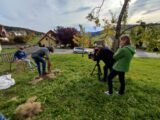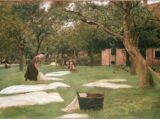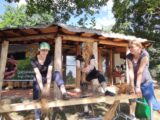Ever since people settled down, farm labour has been associated with many rituals, customs, superstitions and a little magic. The aim was always to be rewarded with a good harvest for all the hard work.
Celtic customs were adopted during Christianisation and some of them have survived to this day. From maypoles to palm bushes - all these rituals have roots that go back to the Bronze Age. Interestingly, the magical acts surrounding flax are very similar throughout German-speaking Europe and also in the neighbouring countries of the Balkans and Scandinavia. They often involve naked skin, but also long sledging runs in winter.
The preparatory work for a good harvest was already done by the people in winter. In Austria and Switzerland, but also in Sweden, it was "clear the track" when the children set off on their sledges in January. Their job was to pull as long and continuous a track as possible from the mountains into the valley. The longer the run, the longer the flax. People also tried to draw conclusions about flax growth from the length of the icicles.
In February, during the carnival days, the young men were given the chance to ensure a good harvest. High jumps while dancing and without falling down were required. In some regions, the boys danced around the field where the flax was to grow and jumped back and forth across the strip of earth.
Silence and a white shirt
The time of sowing often coincided with a feast day of the Virgin Mary. For the Celts, the goddess of flax and other plant fibres was Freya and in Austria and southern Germany, Freya first became Perchta and finally Saint Mary.
If it was the day of sowing, the day often began with the farmer's wife climbing onto the table and jumping back down again. The further away from the table she
landed all the better. Beforehand, she had washed the farmer's best shirt and the sackcloth also had to be white and clean. There were eggs on the cooker, as they would also play an important role during the day.
Once everything was ready, the farmer asked for God's blessing once again and often walked barefoot and silently across the field, sowing his seed. To make sure that no one spoke and that he did not unintentionally answer calls, the sower clamped a small branch between his teeth.
Once the field had been cultivated, the boiled eggs were thrown up and caught again; here too, the flight altitude is said to promise long flax growth. The family then ate the eggs and buried the shells at the edge of the field. The egg as a symbol of fertility is also found in the tradition of eating fried eggs before sowing
Naked facts
The tradition of sowing naked is much older. Here too, fertility was prayed for with the nakedness. In Scandinavia, it was also said with a wink that sowing naked was to show God that you really had nothing to wear and urgently needed a good harvest. Those who did not walk across the fields completely naked were at least supposed to show their bare buttocks before leaving the field and for very shy farmers, sowing with bare feet was also accepted.
The nude dance of a young girl in the moonlight is also said to have had a positive effect on the harvest. Immediately after cultivation or in June, a wooden stick was placed in the centre of the field to show the flax how high it should grow. So nothing was left to chance to ensure a good harvest. The spell: "Flax grow!" was the final mystical act. The rest was now in God's (the gods') hands.








